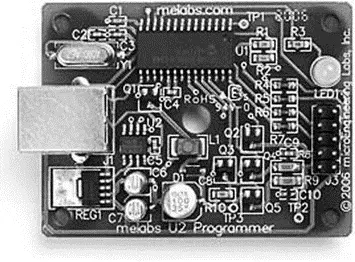
Figure 5.14: Melabs U2 programmer
EasyProg PIC Programmer
The EasyProg PIC is a low-cost programmer (Figure 5.15) used with microcontrollers of the PIC16 and PIC18 series having up to 40 pins. It connects to a PC via a 9-pin serial cable.
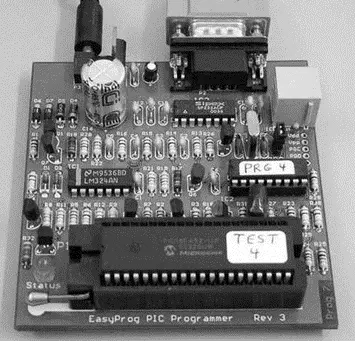
Figure 5.15: EasyProg programmer
PIC Prog Plus Programmer
The PIC Prog Plus is another low-cost programmer (Figure 5.16) that can be used to program most PIC microcontrollers. The device is powered from an external 12V DC supply.
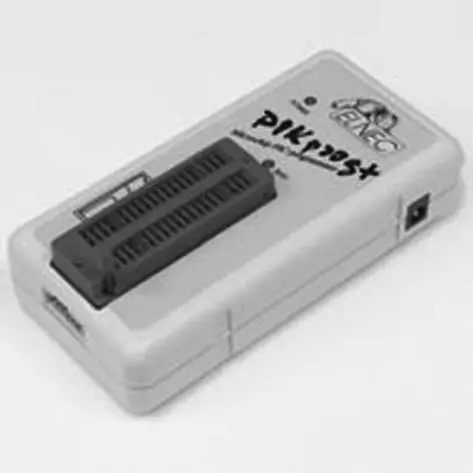
Figure 5.16: PIC Prog Plus programmer
5.2.3 In-Circuit Debuggers
An in-circuit debugger is hardware connected between a PC and the target microcontroller test system used to debug real-time applications quickly and easily. With in-circuit debugging, a monitor program runs in the PIC microcontroller in the test circuit. The programmer can set breakpoints on the PIC, run code, single-step the program, and examine variables and registers on the real device and, if required, change their values. An in-circuit debugger uses some memory and I/O pins of the target PIC microcontroller during debugging operations. Some in-circuit debuggers only debug assembly language programs. Other, more powerful debuggers can debug high-level language programs.
This section discusses some of the popular in-circuit debuggers used in PIC18 microcontroller-based system applications.
ICD2
The ICD2, a low-cost in-circuit debugger (see Figure 5.17) manufactured by Microchip Inc., can debug most PIC microcontroller-based systems. With the ICD2, programs are downloaded to the target microcontroller chip and executed in real time. This debugger supports both assembly language and C language programs.
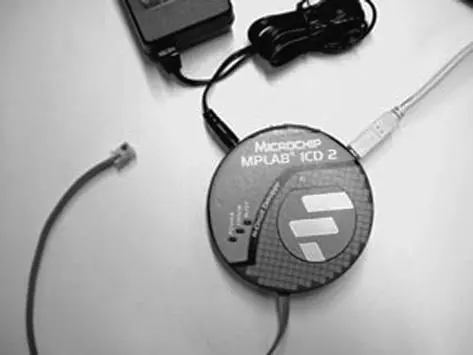
Figure 5.17: ICD2 in-circuit debugger
The ICD2 connects to a PC through either a serial RS232 or a USB interface. The device acts like an intelligent interface between the PC and the test system, allowing the programmer to set breakpoints, look into the test system, view registers and variables at breakpoints, and single-step through the user program. It can also be used to program the target PIC microcontroller.
ICD-U40
The ICD-U40 is an in-circuit debugger (see Figure 5.18) manufactured by Custom Computer Services Inc. to debug programs developed with their CCS C compiler. The device operates with a 40MHz clock frequency, is connected to a PC via the USB interface, and is powered from the USB port. The company also manufactures a serial-port version of this debugger called ICD-S40, which is powered from the target test system.
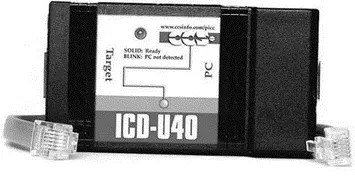
Figure 5.18: ICD-U40 in-circuit debugger
PICFlash 2
The PICFlash 2 in-circuit debugger (see Figure 5.19) is manufactured by mikroElektronika and can be used to debug programs developed in mikroBasic, mikroC, or mikroPascal languages. The device is connected to a PC through its USB interface. Power is drawn from the USB port so the debugger requires no external power supply. The PICFlash 2 is included in the BIGPIC4 development kit. Details on the use of this in-circuit debugger are discussed later in this chapter.

Figure 5.19: PICFlash 2 in-circuit debugger
5.2.4 In-Circuit Emulators
The in-circuit emulator (ICE) is one of the oldest and the most powerful devices for debugging a microcontroller system. It is also the only tool that substitutes its own internal processor for the one in the target system. Like all in-circuit debuggers, the emulator’s primary function is target access—the ability to examine and change the contents of registers, memory, and I/O. Since the emulator replaces the CPU, it does not require a working CPU in the target system. This makes the in-circuit emulator by far the best tool for troubleshooting new or defective systems.
In general, each microcontroller family has its own set of in-circuit emulators. For example, an in-circuit emulator designed for the PIC16 microcontrollers cannot be used for PIC18 microcontrollers. Moreover, the cost of in-circuit emulators is usually quite high. To keep costs down, emulator manufacturers provide a base board which can be used with most microcontrollers in a given family, for example, with all PIC microcontrollers, and also make available probe cards for individual microcontrollers. To emulate a new microcontroller in the same family, then, only the specific probe card has to be purchased.
Several models of in-circuit emulators are available on the market. The following four are some of the more popular ones.
MPLAB ICE 4000
The MPLAB ICE 4000 in-circuit emulator (Figure 5.20), manufactured by Microchip Inc., can be used to emulate microcontrollers in the PIC18 series. It consists of an emulator pod connected with a flex cable to device adapters for the specific microcontroller. The pod is connected to the PC via its parallel port or USB port. Users can insert an unlimited number of breakpoints in order to examine register values.
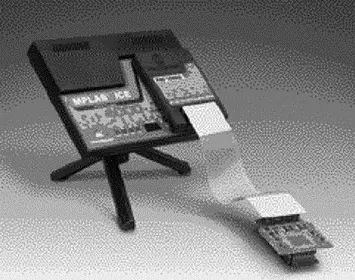
Figure 5.20: MPLAB ICE 4000
RICE3000
The RICE3000 is a powerful in-circuit emulator (Figure 5.21), manufactured by Smart Communications Ltd, for the PIC16 and PIC18 series of microcontrollers.
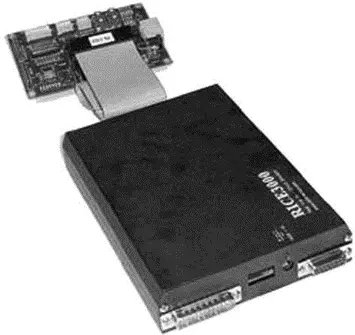
Figure 5.21: RICE3000 in-circuit emulator
The device consists of a base unit with different probe cards for the various members of the PIC microcontroller family. It provides full-speed real-time emulation up to 40MHz, supports observation of floating point variables and complex variables such as arrays and structures, and provides source level and symbolic debugging in both assembly and high-level languages.
ICEPIC 3
The ICEPIC 3 is a modular in-circuit emulator (see Figure 5.22), manufactured by RF Solutions, for the PIC12/16 and PIC18 series of microcontrollers. It connects to the PC via its USB port and consists of a mother board with additional daughter boards for each microcontroller type. The daughter boards are connected to the target system with device adapters. A trace board can be added to capture and analyze execution addresses, opcodes, and external memory read/writes.
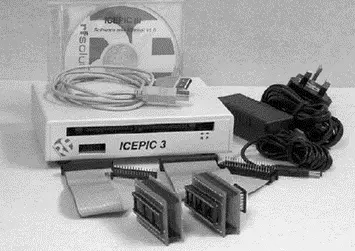
Figure 5.22: ICEPIC 3 in-circuit emulator
PICE-MC
The PICE-MC, a highly sophisticated emulator (see Figure 5.23) manufactured by Phyton Inc., supports most PIC microcontrollers and consists of a main board, pod, and adapters. The main board contains the emulator logic, memory, and an interface to the PC. The pod contains a slave processor that emulates the target microcontroller. The adapters are the mechanical parts that physically connect to the microcontroller sockets of the target system. The PICE-MC provides source-level debugging of programs written in both assembly and high-level languages. A large memory is provided to capture target system data. The user can set up a large number of breakpoints and can access the program and data memories to display or change their contents.
Читать дальше





















